Rama Shanker
Department of Statistics, Eritrea Institute of Technology, Asmara, Eritrea
Correspondence to: Rama Shanker, Department of Statistics, Eritrea Institute of Technology, Asmara, Eritrea.
| Email: |  |
Copyright © 2017 Scientific & Academic Publishing. All Rights Reserved.
This work is licensed under the Creative Commons Attribution International License (CC BY).
http://creativecommons.org/licenses/by/4.0/

Abstract
In this paper, a zero-truncated Poisson-Amarendra distribution (ZTPAD), a zero-truncation of Poisson-Amarendra distribution (PAD) of Shanker (2016 b) has been introduced and investigated. A general expression for the rth factorial moment about origin has been obtained and thus the first four moments about origin and the central moments have been given. The expressions for coefficient of variation, skewness, kurtosis, and the index of dispersion of the distribution have been presented and their graphs for varying values of parameter have been given. The condition under which the ZTPAD is over-dispersed, equi-dispersed and under-dispersed has been compared with that of zero-truncated Poisson-Lindley distribution (ZTPLD) and zero-truncated Poisson-Sujatha distribution (ZTPSD). The method of maximum likelihood estimation and the method of moments have been discussed for estimating its parameter. Application of ZTPAD to a real data set has been given and its goodness of fit has been compared with zero-truncated Poisson distribution (ZTPD), ZTPLD and ZTPSD.
Keywords:
Zero-truncated distribution, Poisson-Amarendra distribution, Poisson-Sujatha distribution, Poisson-Lindley distribution, Moments, Mathematical and statistical properties, Estimation of parameter, Goodness of fit
Cite this paper: Rama Shanker, A Zero-Truncated Poisson-Amarendra Distribution and Its Application, International Journal of Probability and Statistics , Vol. 6 No. 4, 2017, pp. 82-92. doi: 10.5923/j.ijps.20170604.03.
1. Introduction
Zero-truncated distributions, in probability theory, are certain discrete distributions whose support is the set of positive integers. When the data to be modeled originate from a mechanism which generates data excluding zero counts, zero-truncated distributions are the suitable models. A typical example where zero-truncated discrete distributions are useful in medical science is the modeling of duration (in days, months, or years) of patients in hospital. In ecology, zero-truncated discrete distributions are used to model data relating to counts of fin rays on fish, dolphin group size, and age of animals in months or years. In sociology, these distributions are used for modeling group size of human being at park, beach or public places. Now a day, zero-truncated distributions have applications in almost every branch of knowledge including biological science, medical science, psychology, ecology, demography, political science etc. Suppose  is the original distribution. Then the zero-truncated version of
is the original distribution. Then the zero-truncated version of  is defined as
is defined as  | (1.1) |
The Poisson-Amarendra distribution (PAD) having probability mass function (pmf)  | (1.2) |
was introduced by Shanker (2016 b) to model count data in different fields of knowledge. The PAD arises from the Poisson distribution when its parameter  follows Amarendra distribution introduced by Shanker (2016 a) with probability density function (pdf)
follows Amarendra distribution introduced by Shanker (2016 a) with probability density function (pdf) | (1.3) |
Detailed discussion about its various mathematical and statistical properties, estimation of parameter and applications for modeling lifetime data has been mentioned in Shanker (2016 a) and shown by Shanker (2016 a) that (1.3) is a better model than the exponential distribution, Lindley (1958) distribution and Sujatha distribution of Shanker (2016 c) for modeling lifetime data from engineering and biomedical sciences. Shanker and Hagos (2016 a) has discussed the applications of Poisson-Amarendra distribution in different fields of knowledge and concluded that in majority of data sets Poisson-Amarendra distribution gives better fit than Poisson, Poisson-Lindley and Poisson-Sujatha distributions. The motivation for considering ZTPAD is that Amarendra distribution has been shown to be a better model than exponential, Lindley and Sujatha distributions and Poisson-Amarendra distribution (PAD) has also been shown to be a better model for discrete data than Poisson-Lindley distribution (PLD and Poisson-Sujatha distribution (PSD) and for these reasons it is expected that ZTPAD will give better fit than ZTPD, ZTPLD and ZTPSD. In this paper, a zero-truncated Poisson-Amarendra distribution (ZTPAD) has been proposed by taking the zero-truncated version of Poisson-Amarendra distribution (PAD) introduced by Shanker (2016 b). The first four moments about origin and the central moments of ZTPAD have been obtained and thus expressions for coefficients of variation, skewness, kurtosis, and index of dispersion have been given. Estimation of its parameter has been discussed using maximum likelihood estimation and method of moments. Finally, an application of ZTPAD to a real data set has been given to test its goodness of fit over zero-truncated Poisson distribution (ZTPD), Zero-truncated Poisson-Lindley distribution (ZTPLD), and zero-truncated Poisson-Sujatha distribution (ZTPSD).
2. Zero-Truncated Poisson-Amarendra Distribution
Using (1.1) and (1.2), the pmf of zero-truncated Poisson-Amarendra distribution (ZTPAD) can be obtained as | (2.1) |
The nature of a distribution such as coefficient of skewness, kurtosis, and index of dispersion depends on the moments. In case of ZTPAD it seems a little bit difficult and complicated to obtain moment directly. To obtain raw moments in easy way firstly the pmf of ZTPAD has been obtained by mixing size-biased Poisson distribution (SBPD) with an assumed continuous distribution. Since the parameter of the Poisson distribution assumes nonnegative values, it has been assumed that the parameter of the Poisson distribution follows a continuous distribution having support nonnegative values.Suppose the parameter  of the size-biased Poisson distribution (SBPD) having pmf
of the size-biased Poisson distribution (SBPD) having pmf | (2.2) |
follows a continuous distribution having pdf | (2.3) |
Thus the pmf of ZTPAD can be obtained as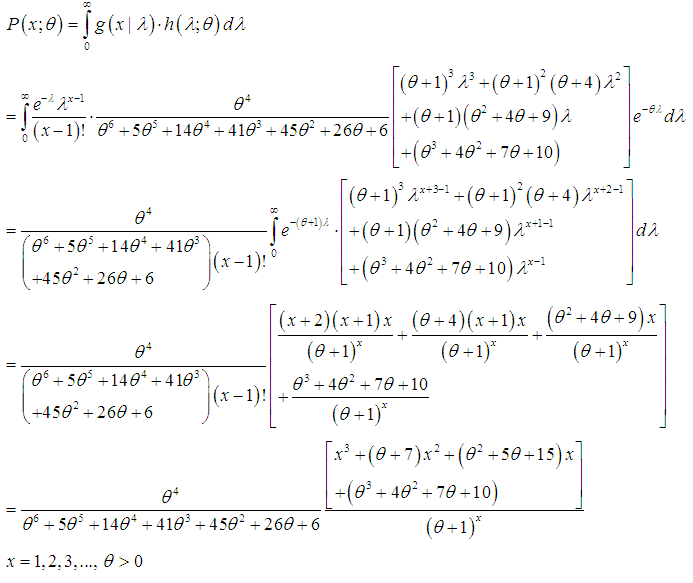 | (2.4) |
which is the pmf of ZTPAD with parameter  , same as given in (2.1).The pmf of zero-truncated Poisson-Sujatha distribution (ZTPSD) obtained by Shanker and Hagos (2015 a) is given by
, same as given in (2.1).The pmf of zero-truncated Poisson-Sujatha distribution (ZTPSD) obtained by Shanker and Hagos (2015 a) is given by | (2.5) |
It is to be recalled that Shanker and Hagos (2015 a) obtained ZTPSD by zero-truncating the discrete Poisson- Sujatha distribution introduced by Shanker (2016 d). Further, the discrete Poisson-Sujatha distribution is the Poisson mixture of Sujatha distribution proposed by Shanker (2016 c). Shanker and Hagos (2016 b) has detailed study on the applications of Poisson-Sujatha distribution modeling count data from biological sciences and showed that it gives better fit than both Poisson and Poisson-Lindley distributions. The pmf of zero-truncated Poisson-Lindley distribution (ZTPLD) obtained by Ghitany et al (2008) is given by | (2.6) |
Recall that ZTPLD has been obtained by zero-truncating the discrete Poisson-Lindley distribution suggested by Sankaran (1970) and the discrete Poisson-Lindley distribution is the Poisson mixture of Lindley distribution introduced by Lindley (1958). Shanker and Hagos (2015 b) have detailed study on applications of Poisson-Lindley distribution for biological sciences. Shanker et al (2015) have detailed study on modeling of lifetime data using both exponential and Lindley distributions and concluded that both exponential and Lindley distributions compete each other.The pmf of zero-truncated Poisson distribution (ZTPD) is given by | (2.7) |
To study the comparative nature and behavior of ZTPAD, ZTPSD, and ZTPLD, various graphs of their pmf for varying values of their parameter have been drawn and presented in figure 1. 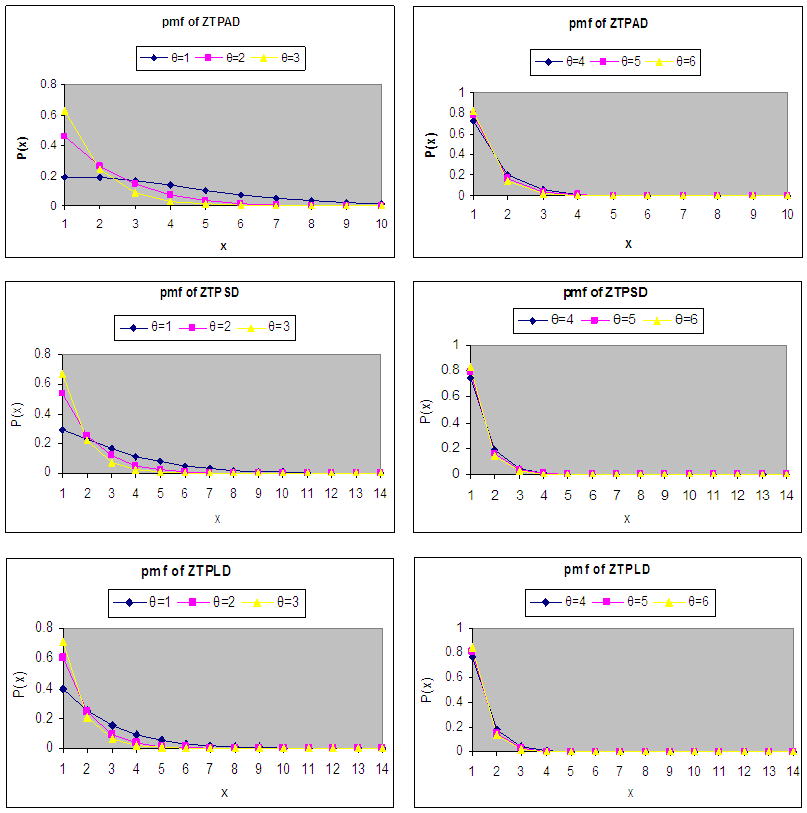 | Figure 1. Graphs of ZTPAD, ZTPSD and ZTPLD for varying values of parameter θ |
A separate graph of the pmf of ZTPAD has also been drawn for varying values the parameter and presented in figure 2. From the figure 2 it is obvious that as the value of parameter  increases, the graphs shift upward initially but decreases rapidly for increasing values of
increases, the graphs shift upward initially but decreases rapidly for increasing values of  .
.  | Figure 2. Graph of the pmf of ZTPAD for varying values of the parameter θ |
As  is a decreasing function of
is a decreasing function of  ,
,  is log-concave. Therefore, ZTPAD is unimodal, has increasing failure rate (IFR), and thus increasing failure rate average (IFRA). It is new better than used (NBU), new better than used in expectation (NBUE), and has decreasing mean residual life (DMRL). The discussions about interrelationships between these aging concepts are available in Barlow and Proschan (1981).
is log-concave. Therefore, ZTPAD is unimodal, has increasing failure rate (IFR), and thus increasing failure rate average (IFRA). It is new better than used (NBU), new better than used in expectation (NBUE), and has decreasing mean residual life (DMRL). The discussions about interrelationships between these aging concepts are available in Barlow and Proschan (1981).
3. Moments of ZTPAD
Using (2.4), the rth factorial moment about origin of ZTPAD (2.1) can be obtained as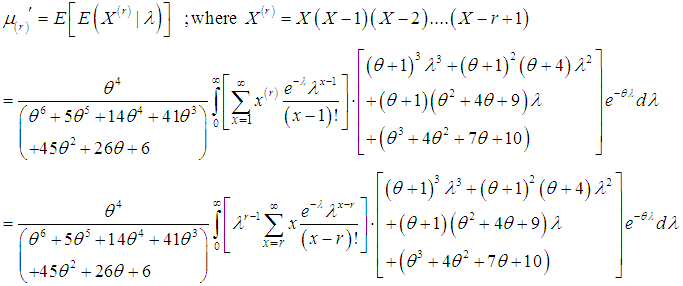 Taking
Taking  , we get
, we get  Using gamma integral and tedious algebraic simplification, we get the expression for the rth factorial moment about origin of ZTPAD (2.1) as
Using gamma integral and tedious algebraic simplification, we get the expression for the rth factorial moment about origin of ZTPAD (2.1) as  | (3.1) |
Substituting r = 1, 2, 3 and 4 in equation (3.1), the first four factorial moments about origin can be obtained and using the relationship between moments about origin and factorial moment about origin, the first four moments about origin of ZTPAD (2.1) can be obtained as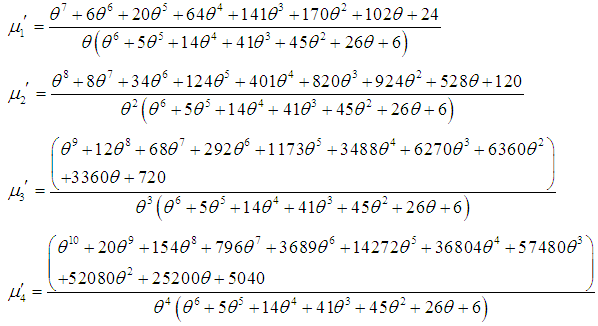 Using the relationship between central moments and moments about origin, the central moments of ZTPAD (2.1) can be obtained as
Using the relationship between central moments and moments about origin, the central moments of ZTPAD (2.1) can be obtained as The coefficient of variation (C.V), coefficient of Skewness
The coefficient of variation (C.V), coefficient of Skewness  , and coefficient of Kurtosis
, and coefficient of Kurtosis  of ZTPAD (2.1) are thus obtained as
of ZTPAD (2.1) are thus obtained as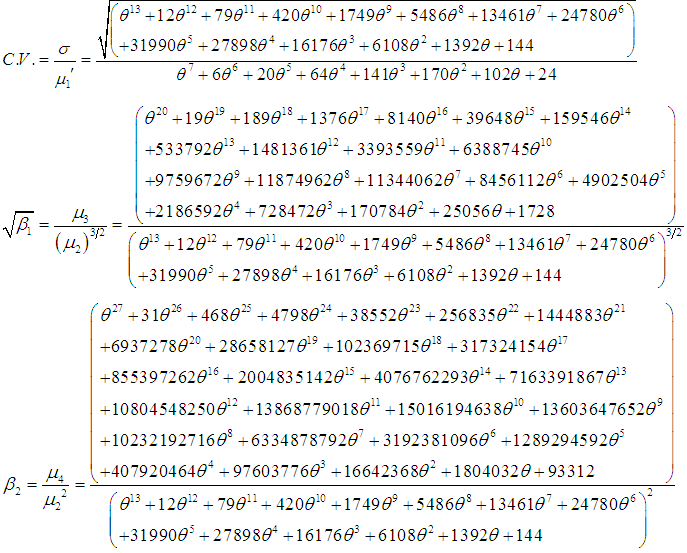 The index of dispersion of ZTPAD (2.1) can be obtained as
The index of dispersion of ZTPAD (2.1) can be obtained as The conditions under which ZTPAD, ZTPSD and ZTPLD are over-dispersed
The conditions under which ZTPAD, ZTPSD and ZTPLD are over-dispersed  , equi-dispersed
, equi-dispersed  and under-dispersed
and under-dispersed  are presented in table 1.
are presented in table 1.Table 1. Condition for over-dispersion, equi-dispersion, and under-dispersion for ZTPAD, ZTPSD and ZTPLD
 |
| |
|
It is clear from table 1 that the point of over-dispersion, equi-dispersion and under-dispersion of ZTPLD, ZTPSD and ZTPAD are increasing for values of the parameter  . For example, the change of dispersion point for ZTPLD is
. For example, the change of dispersion point for ZTPLD is  , whereas the change of dispersion point for ZTPSD and ZTPAD are
, whereas the change of dispersion point for ZTPSD and ZTPAD are  and
and  . To study the nature of
. To study the nature of  ,
,  , C.V,
, C.V,  ,
,  and
and  of ZTPAD, the numerical values of these constants have been prepared for varying values of parameter
of ZTPAD, the numerical values of these constants have been prepared for varying values of parameter  and presented in table 2.
and presented in table 2.Table 2. Numerical values of
 of ZTPAD, ZTPSD and ZTPLD for varying values of parameter θ of ZTPAD, ZTPSD and ZTPLD for varying values of parameter θ
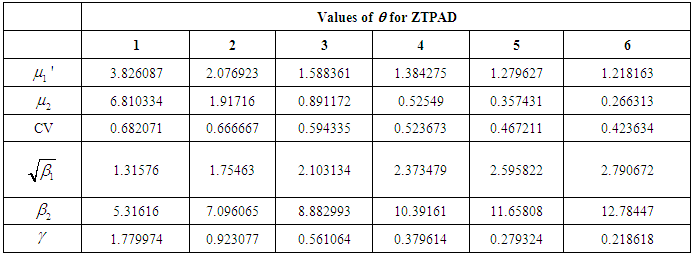 |
| |
|
The graphs of coefficient of variation, coefficient of skewness, coefficient of kurtosis and index of dispersion for varying values of parameter has been drawn and presented in figure 3. It is obvious that the coefficient of variation (C.V) and the index of dispersion are monotonically decreasing while coefficient of skewness and coefficient of kurtosis are increasing for increasing values of the parameter θ, which is obvious from table 2 and graphs in figure 3.  | Figure 3. Graphs of coefficient of variation, coefficient of skewness, coefficient of kurtosis and index of dispersion of ZTPAD for varying values of parameter |
4. Estimation of Parameter
4.1. Method of Moment Estimate (MOME) of parameter: Equating the population mean to the corresponding sample mean, MOME  of
of  of ZTPAD (2.1) is the solution of the following non-linear equation
of ZTPAD (2.1) is the solution of the following non-linear equation where
where  is the sample mean. 4.2. Maximum Likelihood Estimate (MLE) of parameter: Suppose
is the sample mean. 4.2. Maximum Likelihood Estimate (MLE) of parameter: Suppose  be a random sample of size n from the ZTPAD (2.1) and let
be a random sample of size n from the ZTPAD (2.1) and let  be the observed frequency in the sample corresponding to
be the observed frequency in the sample corresponding to  such that
such that  , where
, where  is the largest observed value having non-zero frequency. The likelihood function
is the largest observed value having non-zero frequency. The likelihood function  of the ZTPAD (2.1) is given by
of the ZTPAD (2.1) is given by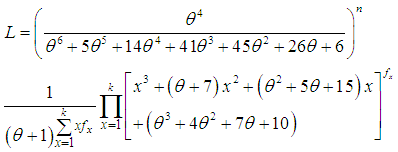 The log likelihood function is given by
The log likelihood function is given by and the log likelihood equation is thus obtained as
and the log likelihood equation is thus obtained as The MLE
The MLE  of
of  is the solution of the equation
is the solution of the equation  and is given by the solution of the following non-linear equation
and is given by the solution of the following non-linear equation where
where  is the sample mean. This non-linear equation can be solved by any numerical iteration methods such as Newton- Raphson method, Bisection method, Regula –Falsi method etc. In the present paper, Newton-Raphson method has been used where the initial value of
is the sample mean. This non-linear equation can be solved by any numerical iteration methods such as Newton- Raphson method, Bisection method, Regula –Falsi method etc. In the present paper, Newton-Raphson method has been used where the initial value of  is the value of MOME
is the value of MOME  of
of  .
.
5. Goodness of Fit
In this section an application of ZTPAD has been discussed with a real data set from biological science and its goodness of fit based of maximum likelihood estimate has been compared with that of ZTPD, ZTPLD and ZTPSD. The data set is due to Finney and Varley (1955), who gave counts of flower heads with 1, 2, 3, 4, 5, 6, 7, 8, 9 fly eggs and the corresponding counts were 22, 18, 18, 11, 9, 6, 3, 0, 1. Finney and Varley (1955) suggested that the data is well modeled by ZTPD. The goodness of fit has been presented in table 3.Table 3. The numbers of counts of flower heads as per the number of fly eggs reported by Finney and Varley (1955)
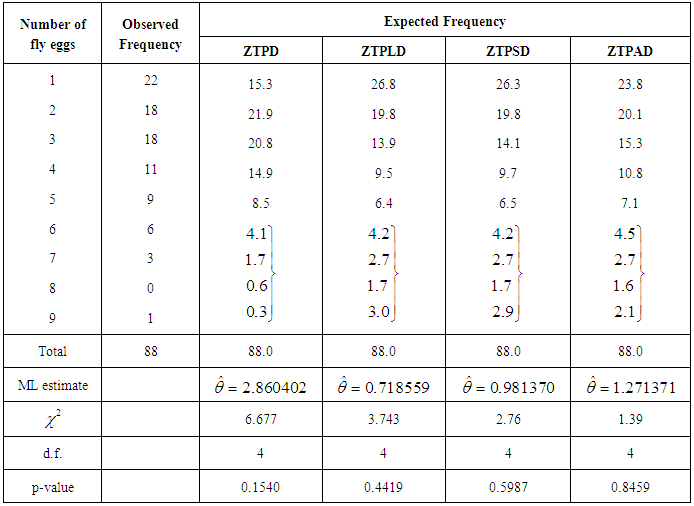 |
| |
|
It is obvious from the goodness of fit in the above table 3 that ZTPAD gives best fit over ZTPD, ZTPLD and ZTPSD and hence it can be considered an important distribution for modeling zero-truncated data from biological sciences.
6. Concluding Remarks
A zero-truncated Poisson-Amarendra distribution (ZTPAD has been introduced and investigated. Its moments about origin and moments about mean have been obtained and moments based measures have been studied. The estimation of parameter has been discussed using both the method of moments and the method of maximum likelihood estimation. An application of ZTPAD to a real data set from biological science has been given and its goodness of fit shows that it gives better fit over zero-truncated Poisson (ZTPD), zero-truncated Poisson-Lindley distribution (ZTPLD) and zero-truncated Poisson-Sujatha distribution (ZTPSD).
ACKNOWLEDGEMENTS
The author is grateful to the editor-in- chief of the journal and the anonymous reviewer for constructive comments which enhanced the quality of the paper.
References
| [1] | Barlow, R.E. and Proschan, F. (1981): Statistical Theory of Reliability and Life Testing, Silver Spring, MD. |
| [2] | Finney, D.J. and Varley, G.C. (1955): An example of the truncated Poisson distribution, Biometrics, 11, 387-94. |
| [3] | Ghitany, M.E., Atieh, B. and Nadarajah, S. (2008 a): Lindley distribution and Its Applications, Mathematics Computation and Simulation, 78, 493-506. |
| [4] | Ghitany, M.E., Al-Mutairi, D.K. and Nadarajah, S. (2008 b): Zero-truncated Poisson-Lindley distribution and its Applications, Mathematics and Computers in Simulation, 79 (3), 279-287. |
| [5] | Lindley, D.V. (1958): Fiducial distributions and Bayes’ theorem, Journal of the Royal Statistical Society, Series B, 20, 102-107. |
| [6] | Sankaran, M (1970): The discrete Poisson-Lindley distribution, Biometrics, 26, 145-149. |
| [7] | Shanker, R. (2016 a): Amarendra Distribution and Its Applications, American Journal of Mathematics and Statistics, 6(1), 44-56. |
| [8] | Shanker, R. (2016 b): The Discrete Poisson-Amarendra Distribution, International Journal of Statistical Distributions and Applications, 2(2), 14-21. |
| [9] | Shanker, R. (2016 c): Sujatha Distribution and Its Applications, Statistics in Transition-New Series, 17(3), 1-20. |
| [10] | Shanker, R. (2016 d): The Discrete Poisson-Sujatha Distribution, International Journal of Probability and Statistics, 5(1), 1-9. |
| [11] | Shanker, R., Hagos, F. and Sujatha, S. (2015): On modeling of lifetimes data using exponential and Lindley distributions, Biometrics & Biostatistics International Journal, 2(5), 1-9. |
| [12] | Shanker, R. and Hagos, F. (2015 a): Zero-truncated Poisson-Sujatha distribution with Applications, Journal of Ethiopian Statistical Association, 24, 55-63. |
| [13] | Shanker, R. and Hagos, F. (2015 b): On Poisson-Lindley distribution and Its Applications to Biological Sciences, Biometrics & Biostatistics International Journal, 2(4), 1-5. |
| [14] | Shanker, R., Hagos, F., Sujatha, S. and Abrehe, Y. (2015): On Zero-Truncation of Poisson and Poisson-Lindley distributions and Their Applications: Biometrics & Biostatistics International Journal, 2(6), 1-14. |
| [15] | Shanker, R. and Hagos, F. (2016 a): On Poisson-Amarendra Distribution and Its Applications, Biometrics & Biostatistics International Journal, 4(3), 1-10. |
| [16] | Shanker, R. and Hagos, F. (2016 b): On Poisson-Sujatha Distribution and Its Applications to Model count data from Biological Sciences, Biometrics & Biostatistics International Journal, 3(4), 1-7. |



 is the original distribution. Then the zero-truncated version of
is the original distribution. Then the zero-truncated version of  is defined as
is defined as 

 follows Amarendra distribution introduced by Shanker (2016 a) with probability density function (pdf)
follows Amarendra distribution introduced by Shanker (2016 a) with probability density function (pdf)

 of the size-biased Poisson distribution (SBPD) having pmf
of the size-biased Poisson distribution (SBPD) having pmf


 , same as given in (2.1).The pmf of zero-truncated Poisson-Sujatha distribution (ZTPSD) obtained by Shanker and Hagos (2015 a) is given by
, same as given in (2.1).The pmf of zero-truncated Poisson-Sujatha distribution (ZTPSD) obtained by Shanker and Hagos (2015 a) is given by



 increases, the graphs shift upward initially but decreases rapidly for increasing values of
increases, the graphs shift upward initially but decreases rapidly for increasing values of  .
. 
 is a decreasing function of
is a decreasing function of  ,
,  is log-concave. Therefore, ZTPAD is unimodal, has increasing failure rate (IFR), and thus increasing failure rate average (IFRA). It is new better than used (NBU), new better than used in expectation (NBUE), and has decreasing mean residual life (DMRL). The discussions about interrelationships between these aging concepts are available in Barlow and Proschan (1981).
is log-concave. Therefore, ZTPAD is unimodal, has increasing failure rate (IFR), and thus increasing failure rate average (IFRA). It is new better than used (NBU), new better than used in expectation (NBUE), and has decreasing mean residual life (DMRL). The discussions about interrelationships between these aging concepts are available in Barlow and Proschan (1981). Taking
Taking  , we get
, we get  Using gamma integral and tedious algebraic simplification, we get the expression for the rth factorial moment about origin of ZTPAD (2.1) as
Using gamma integral and tedious algebraic simplification, we get the expression for the rth factorial moment about origin of ZTPAD (2.1) as 
 Using the relationship between central moments and moments about origin, the central moments of ZTPAD (2.1) can be obtained as
Using the relationship between central moments and moments about origin, the central moments of ZTPAD (2.1) can be obtained as The coefficient of variation (C.V), coefficient of Skewness
The coefficient of variation (C.V), coefficient of Skewness  , and coefficient of Kurtosis
, and coefficient of Kurtosis  of ZTPAD (2.1) are thus obtained as
of ZTPAD (2.1) are thus obtained as The index of dispersion of ZTPAD (2.1) can be obtained as
The index of dispersion of ZTPAD (2.1) can be obtained as The conditions under which ZTPAD, ZTPSD and ZTPLD are over-dispersed
The conditions under which ZTPAD, ZTPSD and ZTPLD are over-dispersed  , equi-dispersed
, equi-dispersed  and under-dispersed
and under-dispersed  are presented in table 1.
are presented in table 1. . For example, the change of dispersion point for ZTPLD is
. For example, the change of dispersion point for ZTPLD is  , whereas the change of dispersion point for ZTPSD and ZTPAD are
, whereas the change of dispersion point for ZTPSD and ZTPAD are  and
and  . To study the nature of
. To study the nature of  ,
,  , C.V,
, C.V,  ,
,  and
and  of ZTPAD, the numerical values of these constants have been prepared for varying values of parameter
of ZTPAD, the numerical values of these constants have been prepared for varying values of parameter  and presented in table 2.
and presented in table 2.
 of
of  of ZTPAD (2.1) is the solution of the following non-linear equation
of ZTPAD (2.1) is the solution of the following non-linear equation where
where  is the sample mean. 4.2. Maximum Likelihood Estimate (MLE) of parameter: Suppose
is the sample mean. 4.2. Maximum Likelihood Estimate (MLE) of parameter: Suppose  be a random sample of size n from the ZTPAD (2.1) and let
be a random sample of size n from the ZTPAD (2.1) and let  be the observed frequency in the sample corresponding to
be the observed frequency in the sample corresponding to  such that
such that  , where
, where  is the largest observed value having non-zero frequency. The likelihood function
is the largest observed value having non-zero frequency. The likelihood function  of the ZTPAD (2.1) is given by
of the ZTPAD (2.1) is given by The log likelihood function is given by
The log likelihood function is given by and the log likelihood equation is thus obtained as
and the log likelihood equation is thus obtained as The MLE
The MLE  of
of  is the solution of the equation
is the solution of the equation  and is given by the solution of the following non-linear equation
and is given by the solution of the following non-linear equation where
where  is the sample mean. This non-linear equation can be solved by any numerical iteration methods such as Newton- Raphson method, Bisection method, Regula –Falsi method etc. In the present paper, Newton-Raphson method has been used where the initial value of
is the sample mean. This non-linear equation can be solved by any numerical iteration methods such as Newton- Raphson method, Bisection method, Regula –Falsi method etc. In the present paper, Newton-Raphson method has been used where the initial value of  is the value of MOME
is the value of MOME  of
of  .
.  Abstract
Abstract Reference
Reference Full-Text PDF
Full-Text PDF Full-text HTML
Full-text HTML
 of ZTPAD, ZTPSD and ZTPLD for varying values of parameter θ
of ZTPAD, ZTPSD and ZTPLD for varying values of parameter θ 
